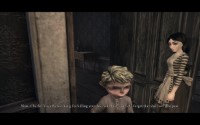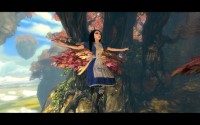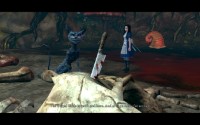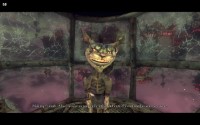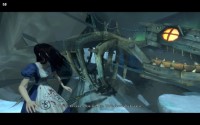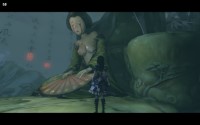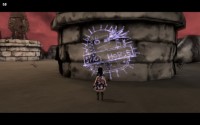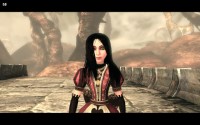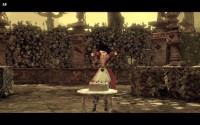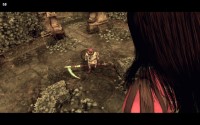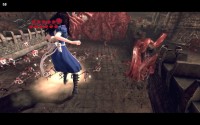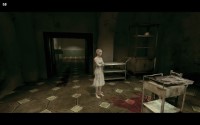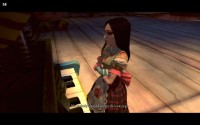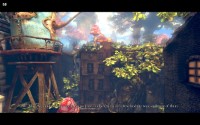Alice: Madness Returns
Playtime: 15.6 Hours
Finished 07 January 2024.Played the game on Normal difficulty with the Steam Deck using the 60FPS engine fix. Finished the game but didn't bother with NG+ or going back to Chapter Select for missed collectibles, since completionist stuff is handled pretty poorly in this game. I completed all Radula Rooms, but missed a number of all other collectibles (memories, bottles, and snouts); the file is at 97%. My IGT is also only 13:08 somehow which is definitely wrong, as I didn't idle very much while playing this game. Maybe it's a side effect of the engine fix or something? Not sure.
I couldn't for the life of me find a good BG image from official art or screenshots, and my own screenshots are at 1280x800 - so this is another fanart background again. Should be quite obvious from the cartoony & sketch quality, but the piece is nice and doesn't obscure half of her body so it'll do. It seems to be by a Nyaka_N on DA, but that user doesn't seem to exist anymore.
So this game is pretty much unplayable with the default 30FPS cap, which is supposedly for physics reasons but is actually probably because of the weak consoles of ~10 years ago. That said, after applying the 60fps fix, the game felt great to play and was a pleasant experience throughout. It definitely has its fair share of rough edges via glitches and janky gameplay, but the core of the game shines, both from a mechanical and aesthetic perspective. Also, as a brief note - I've watched a playthrough of this game before (probably about 10 years ago) so some of the setpieces and story bits probably didn't resonate quite as much as they would have on a true blind playthrough.
I haven't played the first game yet so there is probably a lot of context I'm missing about Alice's background in this interpretation. From what I understand, her entire family was killed in a fire for which she had survivor's guilt, wrecking her psyche and forcing her to be interred in Rutledge Asylum. In the first game, Alice restored her sanity by piecing together her mental Wonderland - after she left the asylum, she moved to an orphanage in London. The plot of Madness Returns basically begins with her Wonderland coming under threat again from an "Infernal Train"; while she wanders somewhat aimlessly throughout London, she effectively encounters a number of hallucinations, each of which is a Chapter in the game and provides some context for where this Train came from and how to prevent it. I kind of find it thematically similar to Psychonauts, except Alice is the victim exploring her own mind. The tone is also much darker and far more personal than the zany environments of Psychonauts, and I really like the way it incorporates the characters of Alice in Wonderland (plus Through the Looking-Glass) into the game without using them for cheap humor or surprises. It feels similar to how the Brothers' Grimm's fairytales were sanitized into the happy-go-lucky versions we have today, except backwards.
I found the plot twists towards the end of the game to be quite shocking, and very well executed. There is a ton of foreshadowing that most of the adults that Alice knows in the real London aren't the best people and often have ulterior motives in mind when "helping" her - but I feel like the writing anticipates you for a certain degree of villainy that is very different than the depths to which Dr. Bumby goes to, as you find out at the end of the game. From Radcliffe hunting for her inheritance, and Nancy blackmailing her for pocket change, you'd expect that Bumby is hunting for some kickbacks or public recognition of some sort; to learn that his orphanage and his motto of "forgetting" the negative things in life was all to turn the orphans into empty-headed prostitutes is incredibly vile and also makes you question the motives of even the more "ordinary" people that Alice meets in the real world. Moreover, Alice's realization that Bumby was not only the arsonist who actually set her house on fire, but also raped her sister Elizabeth before doing so (motivated by her rejection) is the icing on the shit cake of deplorability. It makes his death at Alice's hands all the sweeter (if only it was a bit more gory), and very neatly wraps up the two games in a pretty clean arc. There was a third game called Alice: Asylum in production for a while, which was ultimatelly cancelled because of EA's shenanigans - but at least the series still feels complete.
Visually, this game is quite a treat - both for its time, and even now. It's stylized in a pretty distinct way that doesn't make it look too aged despite relatively low quality models & textures - especially in London, there is a very "ugly blocky British" style to the characters that looks so wrong, yet feels so right for some reason. Within the Wonderland stages themselves, everything is a motif of some kind, either a reference to the original stories or to the psychological themes present in the game. There's far too many to list - but the pig snouts, advice-giving caterpillar, violent queen of hearts (more prevalent in the first game), the insanity of the hatter, and the Cheshire cat as Alice's only constant ally - all feel about as naturally integrated as you can get into a world that is so fundamentally defined by insanity to begin with. I really like how her dress changes for each area, making her feel more like a part of the world (it is her Wonderland, after all...) instead of being a visitor to one. Each one has Roman symbols printed on the front symbolizing the different themes of the game and the background context of each Chapter that you play which is a neat touch. Also, with regards to the physics - even with the 60fps engine fix, physics looked perfectly fine to me; this is one of the earlier games to utilize PhysX for hair, and it still looks surprisingly great! There aren't many other utilizations of the physics engine from what I can tell but what was there looked nice.
The combat in this game feels quite satisfying, if a bit simplistic. Alice's primary weapon is the Vorpal Blade, which is a very fast slashing weapon that resembles a large, bloodied kitchen knife with glowing runes embossed on it. When upgraded, Alice can attack almost as quickly as you can press the attack button for very formidable DPS, easily able to stunlock even heavier enemies to death. Later on, you also find the Hobby Horse as a heavier alternative for melee but I found that its attacks were too slow to use for combat, making it only useful for breaking enemy guards. The Pepper Grinder is a fairly typical machine-gun type weapon, and the Teapot rounds out Alice's main loadout as a mortar providing massive ranged damage and a better method to break guards than the Horse. I'll ignore the Clockwork Rabbit because I thought it was completely useless in combat; it's supposed to draw out enemies but I felt like it got destroyed too easily and didn't draw enough aggro. This is one of relatively few action games where I found myself actively switching between weapons during fights instead of spamming a single combo or attack to win.
The enemy variety is decent for length of the game, but the utilization of said enemies is quite lacking. Pretty much every chapter introduces a light enemy to fit with the level's theme, most of which more or less act the same - dodge around a bit, charge at you after, and maybe block if they have some kind of shield. There is a lot more variety in the heavy enemies; from the teapots firing their mortars at you, to the giant doll that you need to break apart before you can destroy its heart. These have more interesting and varied attacks to dodge and generally take more effort to kill as would be expected; this is also where I found the variety of my arsenal to be the most useful. There are also a number of flying enemies - 2 types (bolterflies & ink wasps) have hives that infinitely spawn easy-to-kill enemies, and 2 more (drifting ruin & bitch babies) fire ranged attacks at Alice while flying around; I wouldn't say these are particularly interesting to fight either but they are used decently well in tandem with other enemies to create challenging encounters. However, this last bit is my biggest issue with the enemy variety, in that the interesting enemies from one level almost never translate to the next. You hardly see any cannon crabs after Chapter 2, nor any Armored Card Guards after Chapter 4, so you almost never need to face a variety of different abilities at once outside of a few special challenge encouters.
To continue with the "lack" of enemies, most chapters don't have a real boss fight except the last one; there is a super-heavy enemy called the Colossal Ruin that takes a "miniboss" role in a few levels but it doesn't have enough of an identity to be a recognizable, thematically significant boss of any chapter - it's just another little hurdle that usually isn't even that difficult to kill, and each fight is pretty much the same kiting affair until its dead. Speaking of which, the enemies are incredibly easy to cheese in this game, and (as mentioned) the colossal ruin is no different. Many enemies can be chain-broken by spamming the teapot cannon at them, and most lack reliable long-range damage to counter Alice spamming either of her ranged weapons. The dodge is very generous and can generally be used to avoid all damage in almost any situation unless you suck; I kind of suck, so it didn't always work out for me though. Even the colossal can be kited into a pillar, completely nullifying his most dangerous flamethrower attack. Even though I usually played a bit more aggressively, I imagine it would be very easy to play this game in a very lazy manner by just manipulating AI if you really wanted to.
Outside of the combat, the rest of the game's puzzle & platforming gameplay is handled quite well, though it remains fairly rudimentary throughout. There's a shrinking mechanic (Drink Me) that can be used to find secret platforms and fit through small keyhole passages. There are buttons that can be pressed, which are usually meant to be held down using the clockwork rabbit, and dials that need to be spun by firing the pepper grinder at them for a while. Oh, there are also levers that you can run up to and pull and fragile walls you can break (with the Hobby Horse or Teapot Cannon). Pretty much every puzzle in the game is just some combination of these elements, stitched together with some light platforming. Speaking of which, Alice has the ability to do a pretty interesting hover/"twirl" in this game which effectively functions as a quadruple jump, useful for crossing a lot of the long gaps during platforming segments. There are a range of collectibles and quite a few mini-secrets containing teeth (upgrade currency) that you can find, which strike a balance of not being too difficult to find while also requiring you to explore each area a little bit. These aren't particularly extraordinary, but a major gripe when dealing with these is that the camera will sometimes force a perspective change in these smaller secret areas which completely fucks up your character movement. While your direction does correctly maintain its previous polarity, the sudden snap to a different angle is still disorienting and occasionally caused me to fall into pits on accident. That said, it's a relatively minor nitpick and kind of a testament to the fact that the platforming feels great for the most part.
This game is quite glitchy and janky by any standard, which is definitely saying something since I really wasn't trying to break the game (I swear). There are some common issues with enemy hitboxes and dodge timing, particularly with the menacing ruin - whose fireballs seem to have some improperly-programmed reflect timing. From what I can tell, the umbrella has to open AFTER the fireball is thrown to register a reflect, and fully open when the fireball actually strikes, else Alice gets stunned into a followup fireball. This basically makes that attack impossible to reflect at close range, which probably isn't intentional. There's also no shortage of enemies shooting you through walls or other objects (the colossal's flamethrower is very good at doing this). When exploring levels outside of combat, there are also lots of situations where I've gotten stuck inside or fallen through the level, and sometimes you get stuck in shrunk mode near complex geometry too. This was especially awful in Chapter 3 due to all the uneven rock surfaces, but still happened on occasion during the other chapters as well. The speedrun seems to use a ton of these glitches to essentially annihilate the game.
One of the most common complaints with this game, outside of all the bugs and jank, is that it feels too long for the substance that it has. I can kind of see where people are coming from, as it's a decent bit longer than the previous game, doesn't have any chapter bosses, and has somewhat of a lack of enemy variety throughout the game, but I never felt like any of the levels really started to drag. Most chapters have you visiting a number of distinct areas, and typically only spends an hour or two within any given environment including addition exploring for collectibles and minigames - far from feeling overdone in my opinion. The lack of gameplay variety might start to become a problem if trying to really binge this game within just a couple of days, but at the pace of a few hours a day I found it quite refreshing how the scenery would change, and conversely felt like the monotonous combat & puzzle diversity was a bit relaxing. Whatever the case, I really enjoyed my time with this game - though I'm doubtful that I'll have enough interest to play through all the stages again.
